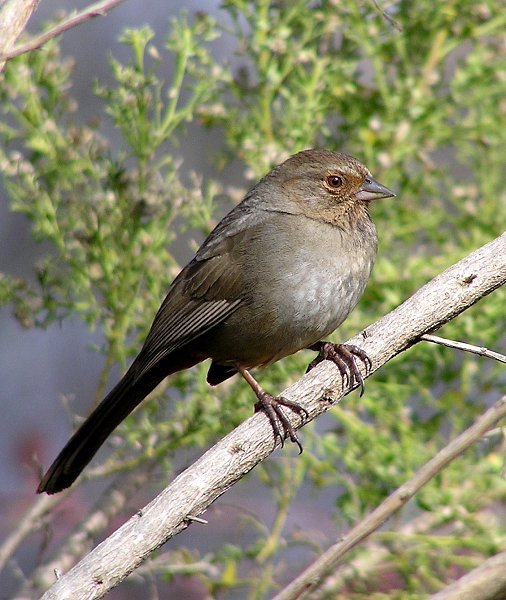
Photo © by Leslie
Newbury Park, Thousand Oaks, Ventura County, California, 17 January 2004
- Melozone crissalis
Pipilo crissalis
Identification
A drab, chunky, long-tailed bird of dense thickets.
Similar Species
Both this species and its close relative the Canyon Towhee have reddish-brown undertail coverts. The California Towhee can be separated by the additional reddish-brown color on the bird's face and the faint streaking on the breast. The Canyon Towhee has a paler face pattern with more contrast and darker spots on the breast.
Distribution
Southern Oregon, California, and Baja California in Mexico.
Taxonomy
Was formerly placed in genus Pipilo.
Formerly considered conspecific with the Canyon Towhee under the name Brown Towhee.
Subspecies
Eight subspecies are recognized1:
- M. c. bullata: Semi-arid south-western Oregon and extreme north-central California
- M. c. carolae: Interior California (Humboldt County to Kern County)
- M. c. petulans : Coastal northern California (Humboldt County to Santa Cruz County)
- M. c. crissalis: Coastal central California (northern Monterey to Kern and Ventura counties)
- M. c. eremophila: East-central California (Argus Mountains and north-western San Bernardino County)
- M. c. senicula: Coastal southern California (Los Angeles County) and north-western Baja California
- M. c. aripolia: Central Baja California (latitude 29°N to 26°30'N)
- M. c. albigula: Cape district of southern Baja California
An additional subspecies wrangeli is generally considered invalid3.
Habitat
Dense thickets, especially near water. The California Towhee has greater tolerance for human disturbance than the Spotted Towhee and will nest in built-up areas where bushes and ground cover are present.
Behaviour
Typically scratches on the ground with both feet at once. They will often run when disturbed rather than taking flight, and in urban areas, this bird will scurry beneath parked cars as if hiding in brush.
Diet
Forages in leaf litter, often in pairs. The bird can often be heard scratching among the leaves long before it is visible.
Vocalisation
The typical call note is a loud and metallic pink, which may be repeated in a series with varying whistled notes.
References
- Clements, J. F., T. S. Schulenberg, M. J. Iliff, D. Roberson, T. A. Fredericks, B. L. Sullivan, and C. L. Wood. 2018. The eBird/Clements checklist of birds of the world: v2018. Downloaded from http://www.birds.cornell.edu/clementschecklist/download/
- 51st supplement to the AOU checklist of North American birds
- Benedict, L., M. R. Kunzmann, K. Ellison, L. Purcell, R. R. Johnson, and L. T. Haight (2011). California Towhee (Melozone crissalis), version 2.0. In The Birds of North America (A. F. Poole, Editor). Cornell Lab of Ornithology, Ithaca, NY, USA. https://doi.org/10.2173/bna.632
- Rising, J. (2018). California Towhee (Melozone crissalis). In: del Hoyo, J., Elliott, A., Sargatal, J., Christie, D.A. & de Juana, E. (eds.). Handbook of the Birds of the World Alive. Lynx Edicions, Barcelona. (retrieved from https://www.hbw.com/node/62018 on 26 November 2018).
- Avibase
Recommended Citation
- BirdForum Opus contributors. (2025) California Towhee. In: BirdForum, the forum for wild birds and birding. Retrieved 14 May 2025 from https://www.birdforum.net/opus/California_Towhee



